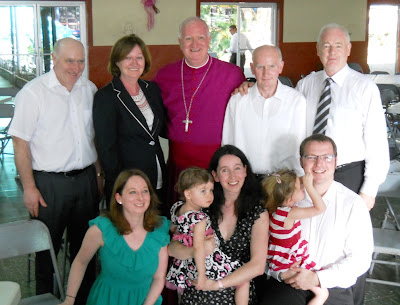 |
| Priests entering the sanctuary on the field in the stadium. |
This past Saturday, February 11, at the municipal stadium in the city of La Ceiba on the north coast of Honduras, in the presence of about 7500 people, Michael Lenihan, OFM, was consecrated first bishop of a new missionary diocese. The celebration actually extended over the course of several days, during which I helped out by making several trips to the San Pedro Sula airport, about two and a half hours away, to pick up family members and friends (priests and religious) coming to participate in the celebration from Ireland, England, Guatemala and the US.
 |
| Fr. Michael stating his willingness to accept the office of bishop. |
It was quite a celebration! It began with the public proclamation of the papal decree establishing the new Diocese of La Ceiba. Mass continued as usual until just after the Gospel, when the rite of ordination took place, beginning with a sung invocation of the Holy Spirit, and then the reading of the mandate from Pope Benedict XVI authorizing Fr. Michael to be ordained a bishop.
 |
Bishop Angel Garachana of San Pedro Sula, one of the three co-ordaining bishops,
imposes his hands on Fr. Michael's head. |
After the homily, Fr. Michael was publicly asked to state his willingness to take on the authority and responsibility of the office of bishop. The Litany of the Saints was sung, and then the three co-ordaining prelates – Cardinal Oscar Andres Rodriguez of Tegucigalpa, Bishop Angel Garachana of San Pedro (from which the Diocese of Ceiba was separated) and the Apostolic Nuncio for Honduras, Bishop Luigi Bianco – all imposed hands on Fr. Michael’s head.
 |
During the prayer of consecration, the Book of the Gospels
is suspended over the new bishop's head. |
The imposition of hands and the prayer of consecration which follows together impart the Sacrament of Holy Orders. During the prayer of consecration two deacons hold the Book of the Gospels above the head of the new bishop, my favorite part of the ceremony.
 |
| Bishop Michael taking over as main celebrant just after the rite of ordination. |
The prayer of consecration concludes with the anointing of sacred Chrism on the head. and the presentation of the Book of the Gospels to the man now charged with proclaiming them. The new bishop then receives the signs of his office: his ring, a mitre (pointed hat) and crosier, or shepherd's staff. Immediately following the Rite of Ordination, the new bishop becomes the main celebrant for the rest of the Mass.
 |
| A campesino couple bringing up gifts at the offertory. |
 |
| Fr. Michael with family members that came from Ireland, England and the US. |
The events of the weekend continued with a reception after Mass, and the next day with an official ceremony at the entrance of the church in which Bishop Michael officially "took possession" of the new cathedral to a crowd packed to overflowing.
 |
At Mass on Sunday morning the new bishop "takes possession" of the new cathedral,
to a packed house (below). |

The whole experience was really overwhelming. There was an almost tangible sense of grace in the air, and a powerful sentiment of hope among everyone who participated. The Church of Christ and Christ Himself came even closer to the people of Ceiba, and they perceived this new presence and responded with overflowing enthusiasm. We were told that there was a notable decrease in violence and crime as the event approached, and people who had been away from the Church were returning. The significance and the impact of the ministry of bishop was brought home to me in a new and deeper way. Somehow the moment in which the Book of the Gospels is held over the new bishop's head expresses that meaning for me: we pray that the Holy Spirit infuse this man with the Gospel so that he can live it, proclaim it, transmit it and make it come alive for those entrusted to his care. It was an experience in which one could see the Church being regenerated and taking a step forward in history and into the lives of the people of Honduras.


